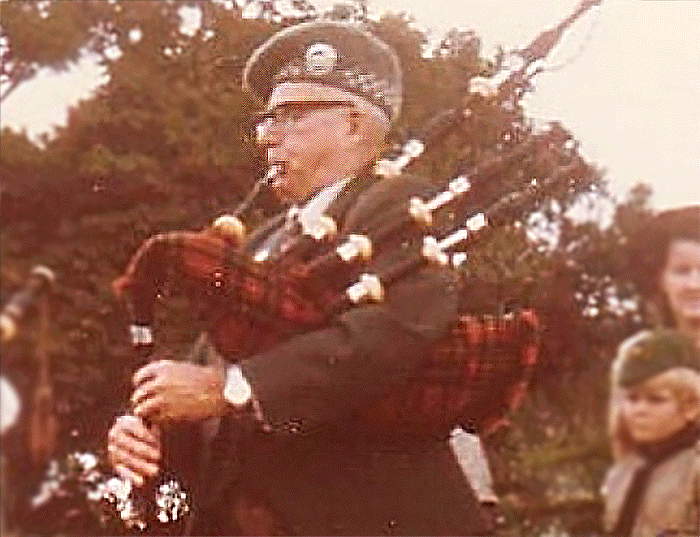
James Kirk MacKinnon was a highly respected piper who worked hard for New South Wales’s Lower Clarence Scottish Association (LCSA) and travelled throughout the state attending gatherings. Although Australian born, Jim’s heart was always for Scotland and he mainly lived to uphold Scottish traditions.
Unfortunately, as with all these fellows, most of those who knew Jim have passed on, and of course at the time we do not think to journal any of them and their piping history, which I do believe to be important.
However I have managed to extract information from newspaper articles, historical society publications and anecdotes of some of the locals in the town of Maclean.
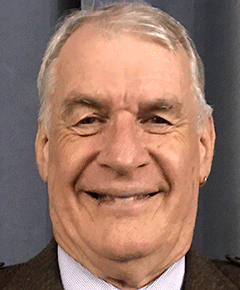
By Dennis Browning
Jim MacKinnon was born in 1897, the son of Malcolm and Georgina MacKinnon of Lower Palmers Island (down river from Maclean). His great grandparents were Malcolm (born 1802) and Euphemia (born 1806) both of whom were from Waternish on the isle of Skye.
Jim was married to Jessie MacPhee and lived on their sugar cane farm on Palmers Island. They had no family.
Jim began playing pipes at the age of 14 and at this early age won his first trophy as junior champion of the Maclean Pipe Band.
Jim served as Pipe Major of the Maclean Pipe Band from 1950 to 1960. Under his skilled leadership this band won many contests. He was also regarded as one of the leading exponents of piobaireachd at the time. It was his passion, though he was a very competent ceòl beag player
Jim’s earlier tuition would have come from Donald Mathieson, Pipe Major of the Maclean Pipe Band 1898, as well as P/M of the Maclean Company of Scottish Rifles Pipes and Drums until his death in 1918. [See pictures below.] He was also influenced by Donald MacSwan, Archie MacColl, Alastair MacSween and to some extent Jim Stewart – all leading pipers in this area at the time.
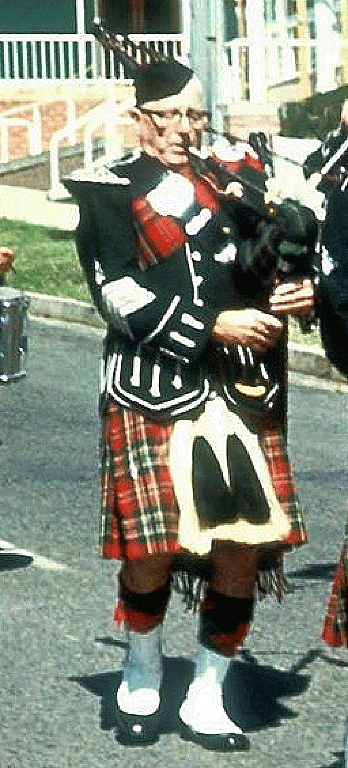
Jim became senior chieftain of the LCSA in 1961 and then Chieftain in 1964 and held that position until his death in 1974. He was made life member in recognition of his service in 1971.
Jim influenced many of the local pipers with his gentle manner and teaching style. For many years he judged the Piobaireachd event at the Maclean Highland Gathering. This Gathering began in 1894 and 2019 saw the 115th contest, with the only interruptions caused by both World Wars.
It was fitting that the LCSA moved that the Maclean piobaireachd championship trophy be named the ‘J.K.MacKinnon Memorial’ in his honour.
On his retirement from the farm, Jim moved to 26 Wharf St, Maclean, about a two minute walk from my family home. As a child I heard Jim play every day and I am sure this was planted into my subconscious and something that was to bear fruit years later.
After moving to Newcastle in1972, I eventually began piping lessons with Michael Haggarty. Mick knew Jim well and suggested I call on him whenever I returned home, which I did.
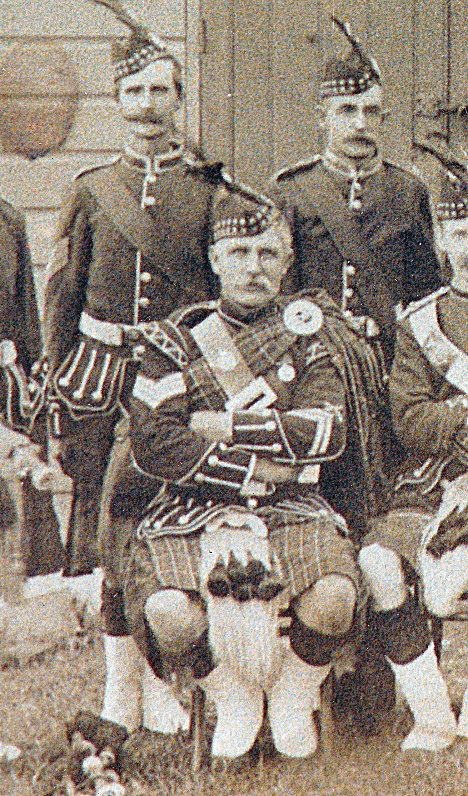
I recall my last contact with Jim. I returned home to Maclean for the Christmas holidays. On Christmas morning 1973, there was a knock on the front door and it was Jim calling to wish me a happy Christmas. After a short conversation he went to his car and brought his pipes out (cocus wood, silver and ivory Hendersons of 1900s vintage). He then played the ground of Scarce of Fishing. What a nice surprise that was!
Jim passed away 15th August 1974 aged 77 and I’m afraid that’s all I have but fortunately to close we also have this wonderful story about him written by Charlie McInnes, late father of noted Australian piper Dr Alastair McInnes.
‘James Kirk MacKinnon was destined to mature to a highly successful cane farmer, the long serving Pipe Major of the Maclean & District pipe Band, a top echelon piobaireachd player and Chieftain of the Lower Clarence Scottish Association.
‘But one cold winter’s day in 1918 he stood, a teenage veteran of the 1st A.I.F.’s French campaigns, shivering before the bitter northerly winds which chilly swept across the ramparts of Edinburgh Castle, mesmerised by the martial music of the celebrated Scots Guards.
‘Too soon the stimulating performance was at an end! The band was dismissed but the pipers and drummers mingled convivially with the spectators braving the elements. Pipe Major Willie Ross crossed the blustery esplanade toward the khaki uniformed figures of Jim and two cobbers, his hand outstretched and a broad smile adorning his countenance.
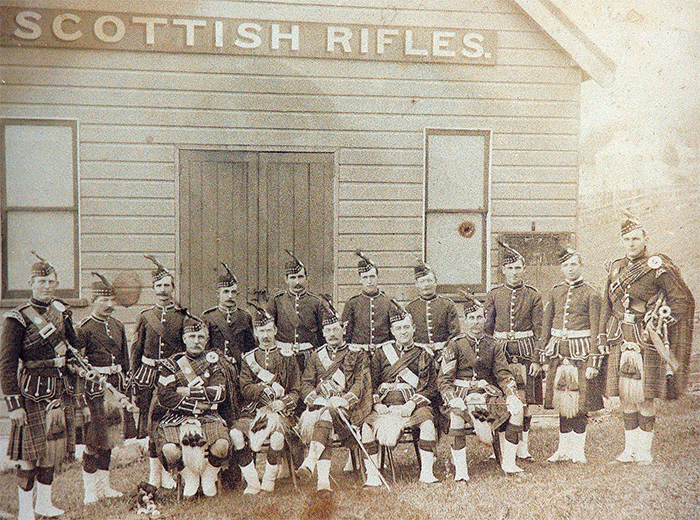
‘After brief words of warm welcome the Pipe Major enquired first if they were partial to the great Highland bagpipe, then if they had enjoyed the ‘ongoings’ and, finally, if all or any were pipers. The affirmative reply of Jim’s two mates drowned out Jim’s modest ‘not really’, at which the Pipe Major turned to his Drum Major and instructed him to re-form the band.
‘The band re-formed, Pipe Major Ross positioned the young Australian on the vacant front left-hand corner, (his normal position), and then enquired of Jim what tunes he played. Jim, though young and ‘colonial’, was an accomplished piper by any standards but shyly and with deference to the great [Scots Guards] band, nominated their regimental march past, Highland Laddie, though he could well have managed many of their most difficult selections.
‘Then the ultimate accolade! Willie Ross passed Jim his silver mounted bagpipe, probably the most celebrated instrument in the long history of piping. With a barely perceptible nod to his Drum Major the band moved off.
‘No youngster with an interest in piping should need to be told of Jim’s elation: playing with the world’s most famous military band on the world’s most illustrious bagpipe.
‘That morning was to live vividly and long in Jim’s extensive memory of piping experiences. But it was a tale he seldom told and then only to those who knew were au fait with the renown of Ross and the grand traditions of piping.’










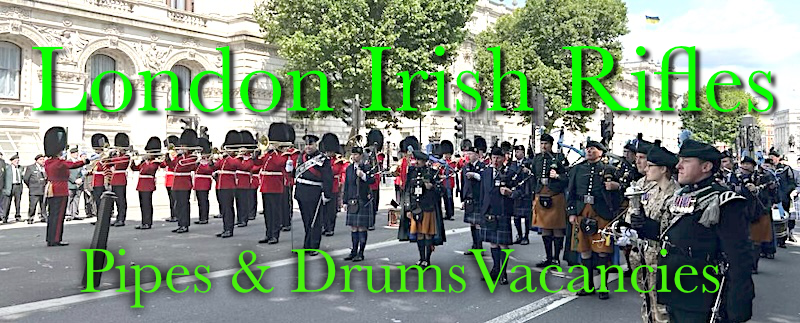






Dennis Browning,
thank you for your message of 31 December. I have gone through my copy of “The Scottish Rifles in Northern New South Wales” published 1985 (signed by the author!). The book gives the names of 11 pipers, including D. Matheson (could that be Donald Mathieson who I have listed as Pipe Major?), but there is no mention at all of Pipe Majors. The names I have of the Pipe Majors come from newspapers at that time. I find it strange that these names are different from the names in the book.
I have no access to “Maclean and the Scottish Connection” – would that mention any Pipe Majors?
Regards
Aad Boode
Further to my message yesterday I would like to add the following.
The Pipes & Drums of the New South Wales Scottish Rifles were formed in 1885, and the regiment had several name changes:
1885 – 1896: Scottish Volunteer Rifle Corps (Scottish Rifles)
1896 – 1897: Scottish Rifles, 5th (Union) Volunteer Regiment
1897 – 1901: 8th (Union) Regiment
1901 – 1903: 5th New South Wales Infantry Regiment (Scottish Rifles)
1903 – 1908: 1st New South Wales Scottish Rifles
1908 – 1912: New South Wales Scottish Rifles
The regiment was disbanded in 1912, but re-raised in 1935 as New South Wales Scottish Regiment in 1935.
Donald Mathieson was P/M in 1887, but I also have the following names of the P/Ms:
– McDonald, Donald (1892?), died early 1890s
– Mackay, Thomas M. (1894?)
– MacDonald, John Baird (1898?), born 1864?, died 1904 Redmond NSW
– Waugh, George (1903?)
– Edmonds, A. (1905?)
– Finlay (1909?)
Has someone more details about this pipe band and its Pipe Majors?
I can recommend two publications that contain quite a bit of detail on the Scottish Rifles – “The Scottish Rifles in New South Wales” by M. Buckley and “Maclean and the Scottish Connection” by E. MacSwan. I obtained both publications from the Maclean Historical Society – web site
http://www.macleanhistory.org.au
Regards
Dennis Browning
Was the Maclean Company of Scottish Rifles a military unit?